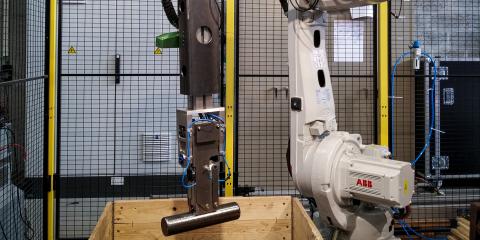Pickit validates a robot with gripper at record speed thanks to 'Infrastructure-as-a-Service' by Flanders Make

Pickit validates a robot with gripper at record speed thanks to 'Infrastructure-as-a-Service' by Flanders Make
Pickit, a scale-up established in Leuven, has been building for several years on its worldwide ambition to give robots eyes. The Pickit 3D cameras and corresponding software connect seamlessly with well-known industrial robots, enabling them to see and grasp objects in their environment. By integrating artificial intelligence in the software, industrial processes such as bin picking can be fully automated. Flanders Make helped them with the validation of a robotic gripper.
Pickit has the ambition to become a global market leader and is therefore permanently in search of innovation. An internal strategic exercise had shown that the software and camera solution was highly dependent on the customer's technical knowledge and integrator capabilities. “We noticed that some partners were faster in obtaining a robust result than others”, says Bert Willaert, CTO of Pickit. “That's why we wanted to test and play integrator ourselves to see what processes our customers have to go through. This would give us a better understanding of our product range. In addition, we wanted to test the possibility of a robotic gripper”, says Bert.
Lack of space and knowledge
Pickit is originally a software company. They operate from an office environment and have little or no infrastructure to test large industrial robots. The company does have experience with lighter cobots, but these run at slow speeds and have lower safety regulations. Bert explains: “Large industrial robots just don't fit in our offices. Besides, we don't have the knowledge in terms of safety and logistics to make such a robot operational ourselves.”
The company first considered renting a warehouse but soon found out that this would involve a considerable investment in both equipment and knowledge. Moreover, it would take several months to set up the whole process. So we started looking for a place where an industrial robot was quickly available, but also for a partner who could help us to make the robot operational”, Bert continues. “We found the solution close by in Leuven with Flanders Make. In less than 6 weeks we had a robot at our disposal and could begin to test.”
Product testing in real conditions with experienced researchers
Thanks to Flanders Make's Infrastructure-as-a-service, Pickit could be helped in no time. Companies that want to innovate need high-tech research infrastructure with which they can evaluate, validate and demonstrate new products and processes”, says Gregory Pinte, R&D Manager at Flanders Make. “It would be a huge investment for these companies to provide the knowledge and equipment for this themselves. That is why at Flanders Make we offer a comprehensive range of test and validation infrastructure in our facilities spread across Flanders. Both large companies and SMEs can test and optimise their new products in real conditions. They can also call on the knowledge and support of our experienced researchers.”
In addition to making equipment available, Infrastructure-as-a-Service can also be expanded to include research, with Flanders Make researchers and experts taking over the innovation project and helping companies to develop and market new products better and faster. Within the scope of Innovation Boosting, Pickit had already worked together with Flanders Make, investigating the feasibility of an innovative software idea. This close relationship ensured that Pickit could be helped quickly, requirements were soon identified and the one-off cooperation evolved smoothly into a structural partnership.
“When Pickit knocked on our door, we acted promptly”, says Gregory. “An industrial robot was made available in record time, relieving them of all logistic concerns about anchoring the robot or building a safety cage.” Pickit now carries out its own bin picking tests and calls on the technical support of Flanders Make, for instance for a new add-on for the robot or assistance and knowledge in safety matters.
Robotic gripper optimisation tests
The tests have been going on for several months now and they will continue for several more months. “We are now achieving incredibly good success rates”, says Bert from Pickit. “Still, in spite of all technological progress, there are still quite a few details that we need to get 100% right to be able to realise an optimal bin picking solution. By testing them within the validation environment, we get to know these details and are able to integrate them into our product, making it even stronger. In addition, we want to allow variations and we also want to test different gripper sizes. Thanks to Flanders Make's infrastructure, we can carry out large-scale tests to prepare our plug-in solution for the market. The customer will then only need to have a robot. We offer a camera, software and gripper that are seamlessly geared to one another. And, thanks to our extensive testing, we can ensure highly reliable success rates.”
At Pickit, they certainly see it big and they continue to search for new innovations. At the moment, together with Flanders Make, they are looking into a new, larger robot and possibly also a second test room. “Soon you will have to start building again”, Bert says with a broad smile.
